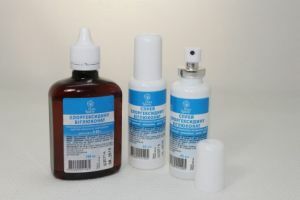 Stomatitis( Latin Stomatitis) is the most common disease of the oral cavity. He is sick about one fifth of the world's population, of which almost half are pregnant women. The reasons for which the disease develops are many. Among the most popular violation of the rules of hygiene, allergy, burn, mechanical trauma, hormonal imbalance.
Stomatitis( Latin Stomatitis) is the most common disease of the oral cavity. He is sick about one fifth of the world's population, of which almost half are pregnant women. The reasons for which the disease develops are many. Among the most popular violation of the rules of hygiene, allergy, burn, mechanical trauma, hormonal imbalance.
During the illness there are sores, which, provided that they are adequately treated, disappear completely within 2 weeks and do not disturb the person in any way.
There are following forms of stomatitis:
- aphthous;
- herpetic;
- candida;
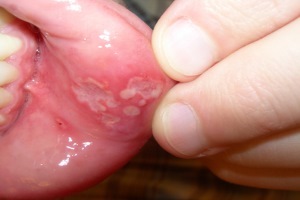
- is allergic;
- bacterial;
- catarrhal;
- is ulcerative;
- is traumatic;
- is vesicular.
For treatment of some forms of stomatitis, doctors prescribe to their patients an antiseptic Chlorhexidine. The use of this drug greatly accelerates the healing of aphthus and destroys bacterial culture in the oral cavity.
Contents
- Chlorhexidine - effective, safe and popular
- Therapy process
- Application in childhood
- Contraindications to use
- Stop by experienced
- Summing up
Chlorhexidine is effective, safe and popular
Chlorhexidine is a popular antiseptic in the Russian Federation and the CIS countries thatsuccessfully used as a universal 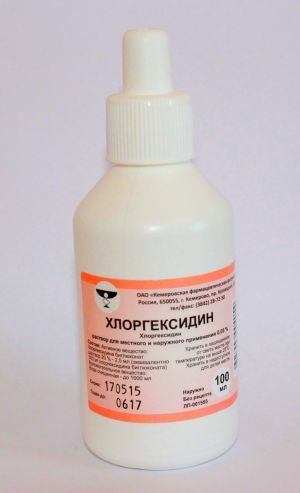 disinfectant and antimicrobial agent.
disinfectant and antimicrobial agent.
The chemical compound chlorhexidine was discovered in the 50s of the XX century in the UK, and after 4 years the first cutaneous antiseptic on the basis of this substance appeared. Later, this substance was infiltrated with urological lubricants, catheters, napkins and sponges, implants, clothes for patients and medical personnel.
Contains as part of some toothpastes and rinse aid for cleansing the oral cavity.
Veterinary specialists also widely use this substance.
The active substance chlorhexidine bigluconate possesses strong disinfecting properties, successfully combats microbes, fungi and viruses. The effect is noticeable after the first use.
Dentists widely use chlorhexidine for the treatment of stomatitis. This preparation forms a thin membrane on the ulcerated mucosa, which is a protection against the effects of bacteria. That is why rinsing the mouth with a solution of Chlorhexidine significantly increases the rate of healing of ulcers and ulcers.
Therapy process
Chlorhexidine is available in various forms:
- aqueous and alcoholic solution;
- gel;
- spray;
- cream;
- suppositories;
- plaster.
In the pharmacy you can find containers with different designations - 0,05%, 0,01%, 0,1%, 1%, 5% and 20%.These numbers indicate the concentration level of the active substance in the solution.
For stomatitis, the liquid form of Chlorhexidine is used most often. Sometimes spray and gel are used. 
Depending on the form and neglect of the disease, the course and dosage of the drug are selected.
If this is a bacterial form of stomatitis, then an aqueous or alcoholic chlorhexidine solution is prescribed in a 0.01% concentration for rinsing the oral cavity. For a complete cure, solutions must be used in which the active substance has a higher concentration. For medicinal rinse the medicine of a room temperature will approach, and to rinse or gargle a mouth it is necessary not less minutes.
In the treatment of candidal stomatitis, the solution is used at a concentration of 0.05%.The drug should be at room temperature, and the procedure itself is recommended for 8-10 minutes.
Doctors believe that Chlorhexidine is a universal medicine in the fight against stomatitis. The main goal is to determine the form of the disease and choose the necessary concentration. In addition, the therapeutic effect continues after the rinsing procedure.
There are basic guidelines for oral care before rinsing with chlorhexidine:
- before rinsing, the maximum hygienic cleaning should be carried out in the mouth: remove residual food in the spaces between the teeth using a flosser, brush and other interdental means;
- then it is necessary to rinse your mouth with boiled water, then you can continue treatment with a medicine.
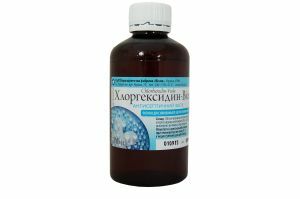 At the end of the procedure, you need to give up food for about a couple of hours. If the pain in the mouth is not too troubling, then two rinses per day is more than enough. With severe discomfort, the number of procedures should be increased to 3-4.
At the end of the procedure, you need to give up food for about a couple of hours. If the pain in the mouth is not too troubling, then two rinses per day is more than enough. With severe discomfort, the number of procedures should be increased to 3-4.
Universal medication for the oral cavity is such traditional drugs as Iodinol, methylene blue, potassium permanganate. Chlorhexidine can be doubly used along with them, as well as with folk remedies - soda and herbs( oak bark, sage, chamomile).
Application in childhood
 In the treatment of stomatitis in children three years and under, the treatment of affected areas occurs using cotton wool soaked in chlorhexidine. You need to do this procedure up to 4 times a day.
In the treatment of stomatitis in children three years and under, the treatment of affected areas occurs using cotton wool soaked in chlorhexidine. You need to do this procedure up to 4 times a day.
Older children already know how to gargle and spit out the remedy, so when confirming the diagnosis, you can apply therapeutic rinses. Before this, it is necessary to clean the mouth of the remaining food by rinsing with warm water. Next, one dessert spoonful of solution will suffice. Rinse should take no more than half a minute. The amount per day is 2 -3 times.
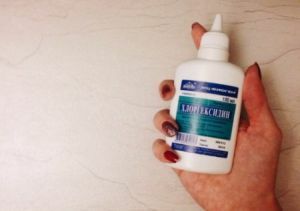 For therapeutic purposes, a spray is also convenient, which can be applied to any problem areas affected by aft.
For therapeutic purposes, a spray is also convenient, which can be applied to any problem areas affected by aft.
Duration of therapy in small patients takes 5-7 days. But quite often the kids flatly protest to rinse with this drug, because it has an unpleasant aftertaste.
The choice of the method of treatment of stomatitis is always preceded by the identification of factors that provoked the disease. If the baby has a viral form of the disease, the doctor can prescribe the use of antiviral drugs. For cleaning and disinfection of the oral cavity, wipe the sores with cotton wool soaked in chlorohexidine solution.
Contraindications to the use of
It is not recommended to use the medication in the following situations:
- if some other antiseptics are planned( Miramistin and others);
- is an allergy to the active ingredient;
- treats children with special care, as well as nursing mothers and pregnant women;
Possible formation of side effects:
- formation of a brown plaque on the teeth;
- discoloration of tooth enamel.
Stop by experienced
Reviews of patients who used rinse with chlorhexidine while treating stomatitis.
Earlier I often suffered from stomatitis - about once a month. On one site, I found positive responses about a 0.05% solution of Chlorhexidine bigluconate. It is sold absolutely in every pharmacy, and it costs very cheaply.
Rinsed 5 times a day, at approximately the same time intervals. The taste is neutral, there is bitterness in the aftertaste. After 4 days, the sores disappeared without a trace, and for three months I have not bothered with stomatitis.
Catherine, 26 years old
Elena, 45 years
Summing up
It is possible to single out such advantages of the medicine: 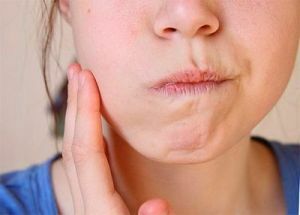
- antimicrobial activity is much higher than in similar drugs;
- availability for any person - there is in any pharmacy, the price is low;
- prolonged antiseptic action due to the formation of a protective membrane.
Disadvantages:
- slightly unpleasant taste;
- viruses are resistant to the drug, so the viral form of stomatitis is weakly treatable with Chlorhexidine;
- with prolonged use of the drug can temporarily stain the surface of the teeth and the tongue in a darkish color.
